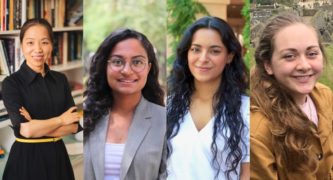
The Caltech Center for Inclusion and Diversity (CCID) recently hosted a panel discussion to mark the International Day of Women and Girls in Science, which took place on February 11. The panel, featuring three Caltech graduate students and an alumna who now works at the Institute, offered a frank but supportive discussion to engage both Caltech and community college students attending the event.
“Although our programs are open to all audiences, our primary focus this year was reaching women in community colleges,” says Yazmin Gonzalez, associate director of CCID. “Expanding entry pathways into STEM for people of minoritized identities requires intentional engagement with community colleges. International Day of Women and Girls in Science is always an optimal opportunity to do that and highlight some of the incredible women scientists at Caltech.”
Each of the panelists discussed their work in STEM and what motivates them to advocate for women in science and engineering fields:
Wen Chen, scientific analyst (PhD ’00):
“I’ve pursued my dream of becoming a scientist since I was 6 years old. I faced many difficulties as a female student majoring in STEM and during the early part of my career. At that time, I wished so much to have some guidance, especially advice from other women in the STEM profession. Now that life is getting better, I want to support other women in the field. It is an honor for me to share my experience.
“I work for WormBase, an online knowledge base that hosts data widely used for scientific research. My role focuses on scientific curation and software development for high-throughput expression analyses. Most researchers use our website daily or weekly. My work is essential for them because high-throughput data must be integrated and computed consistently to provide biologically meaningful information. I enjoy answering user emails and giving outreach seminars at conferences and universities. These interactions with the scientific community help us to understand how people use our resources and form new ideas on data collection and software development.”
Read about the selection of WormBase as one of the first Global Core Biodata Resources (GCBRs) by the Global Biodata Coalition here.
Niyati Desai, graduate student in aerospace engineering:
“My research focuses on building tools for astronomers to image faraway planets in other solar systems. I help design and develop very precise optics to go on future space telescopes to make it possible to find out what the atmospheres and surfaces of these planets might be like.
“It’s important to me to participate in an event like the International Day of Women and Girls in Science because, growing up, it was the women in science in my life who inspired me to pursue my passions and work hard to be where I am today. My high school librarian, my first physics professor, and my college advisers were all women who showed me a path that was possible if I wanted it. I want to express my own enthusiasm and joy for my work and my journey in science to the next generation, and especially encourage young girls to push the limits and boundaries of everything they know.”
Karen Orta, graduate student in biochemistry and molecular biophysics:
“In my research, I study the process by which bacteria build their cell walls. I’m especially interested in the structure and chemistry of proteins that create peptidoglycan, which is generally required by bacteria to survive. By gaining a deeper understanding of these systems, we hope to find new ways to fight bacterial infections and create more effective antibiotics.
“Participating in panels like this is crucial because representation matters! Throughout my graduate studies, I’ve had the privilege of having female scientists as mentors. However, before coming to Caltech, I wasn’t exposed to this kind of diversity. Events like this help break the stereotypes of what a scientist should look like. I am grateful for the chance to change these perceptions for future generations and show that anyone, regardless of gender or background, can be a scientist. By sharing our experiences as women in our respective fields, I hope we can inspire and encourage others to pursue a career in science.”
Jacqueline Tawney, graduate student in aerospace engineering:
“My research focuses on the intersection of polymer physics and fluid dynamics in chemical, aerospace, and mechanical engineering. My favorite application is agricultural, as the polymer solutions I work on can be used to mitigate pesticide waste and contamination. The science can also be used for anything where one might want to control droplet size—for example, explosion mitigation in jet engines—or reduce turbulent drag. I also participate in research on education, and I am a member of the American Society of Engineering Education.
“I want to inspire scientists and engineers to believe in their power to build a world they believe in. It’s easy to get lost in the feeling that it’s impossible to change the status quo and that one needs to conform in order to be successful. I am an example that our differences are actually our strengths, and our unique strengths can be used to evolve our communities into more inclusive spaces for everyone to contribute their fullest, truest, best selves. The STEM field has so much potential to be a truly great service to society, but we must embrace authenticity, compassion, and community as we move toward a brighter future.”
The International Day of Women and Girls in Science was adopted by the United Nations General Assembly in 2015 to address the gender gap at all levels of STEM disciplines around the world. The UN notes that, while progress has been made, women typically receive smaller research grants than men, and female researchers often have shorter and less well-paid careers in STEM.
“This event facilitated a transparent and candid dialogue about the nuanced experiences of women scientists,” Gonzalez says. “The panelists highlighted the importance of community, compassion, healthy boundaries, and self-care to successfully navigating the rigors of a STEM trajectory. My hope is that this information will help community college students consider Caltech, whether through summer research opportunities or for graduate study, as a possibility in their future.”














 1 comment
1 comment


